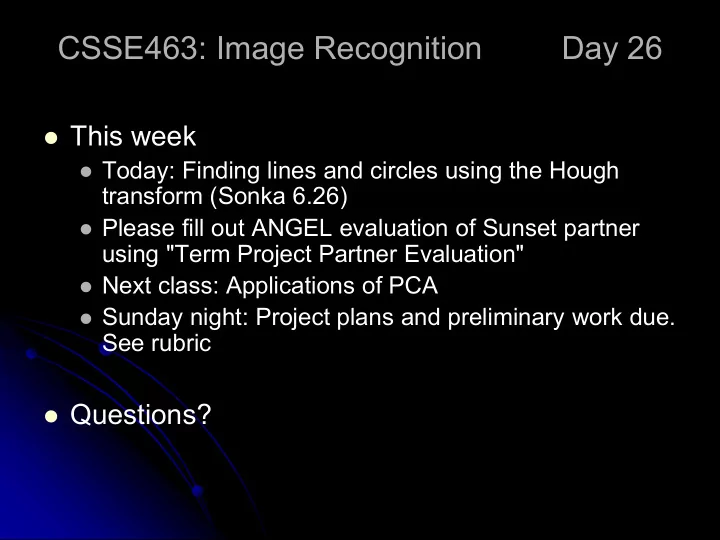

CSSE463: Image Recognition Day 26 This week Today: Finding lines and circles using the Hough transform (Sonka 6.26) Please fill out ANGEL evaluation of Sunset partner using "Term Project Partner Evaluation" Next class: Applications of PCA Sunday night: Project plans and preliminary work due. See rubric Questions?
Finding lines in real images Input: set of edge points Output: the equation of a line containing them Methods: Least-squares (if you know which points belong to the line…) Hough transform (today)
Hough transform Idea (Sonka 6.2.6; Forsyth and Ponce, ch 15) : Represent a line using parameters Each edge point in the image casts a vote for all lines of which it could be part. Only the true line receives lots of votes
Parametric Equation of a Line Represent a line using 2 parameters y = mx + b? Problem? Ax + By + C = 0? 3 parameters; but A, B, and C are related…we only need 2 r and q r is distance from line to origin Q is the angle the distance segment makes with x- axis x cos q + y sin q = r Q1
Voting Each point in image votes for all lines of which it could be part. Only “true” line receives lots of votes. Quiz question: show (4,4), (2,2), and (0,0) voting for a line in y = mx+b space (for simplicity) Q2-3
Perfect line Notice sharp peak in voting space (next 3 images from Forsyth and Ponce, ch 15) Q4
Approximate line Notice the broader peak. Can we detect it? Could smooth or use a coarser quantization? Accumulator array: bin size? Range? Q5
Random noise Votes spead all over the place: no line Too much noise creates “phantom lines” Smoothing can sometimes help Q6
Limitations Finding the right grid size in parameter space may be tricky Trial and error
Matlab Run an edge detector first to find points that are voting [H, theta, rho] = hough(edgeImg); peaks = houghpeaks(H,nPeaks); This works for lines only
Another demo http://www.rob.cs.tu-bs.de/content/04- teaching/06-interactive/HNF.html
Generalizations Finding circles with fixed radius… Finding circles with arbitrary radius… Finding line segments Finding arbitrary shapes… Ballard, Dana. 1981. Generalizing the Hough transform to detect arbitrary shapes. Pattern Recognition , 13(2):111-122. Dana was a long- time member of Rochester’s computer vision group. Q7-8
My Circle Finder Demo Wouldn’t this be a great lab ? Like Matlab’s hough and houghpeaks (for lines), but from scratch Easier would be to find circles of fixed radius.
Reducing the number of votes Use the edge gradient information as well Only need to cast votes for centers along the gradient I’ve done this; it works really well Use partial curves. If you had a way of grouping relating points, you could use curvature. I haven’t tried this.
Recommend
More recommend